1000+ Animal Kingdom MCQ for SSC CGL [Solved]
Thursday 9th of March 2023

Sharing is caring
1. In amphibians, heart is ________ chambered.
A. two
B. three
C. four
D. none of these
Answer : B
A. two
B. three
C. four
D. none of these
Answer : B
2. Which one of the following categories of animals is correctly described with no single exception in it?
A. In chondrichthyes notochord is persistent throughout life.
B. All mammals are viviparous and possess diaphragm for breathing.
C. All sponges are marine.
D. All reptiles possess scales, have a three chambered heart and are cold blooded (poikilothermal).
Answer : A
A. In chondrichthyes notochord is persistent throughout life.
B. All mammals are viviparous and possess diaphragm for breathing.
C. All sponges are marine.
D. All reptiles possess scales, have a three chambered heart and are cold blooded (poikilothermal).
Answer : A
3. The following statement are associated with the occurrence of notochord. Identify the incorrect statement.
A. It is present only in larval tail in ascidians.
B. It is replaced by a vertebral column in adult frog.
C. It is absent throughout the life in humans from the very beginning.
D. It is present throughout life in Amphioxus.
Answer : C
A. It is present only in larval tail in ascidians.
B. It is replaced by a vertebral column in adult frog.
C. It is absent throughout the life in humans from the very beginning.
D. It is present throughout life in Amphioxus.
Answer : C
4. __________ is responsible for maintaining the current of water in sponge.
A. Osculum
B. Porocytes
C. Spongocoel
D. Choanocytes
Answer : D
A. Osculum
B. Porocytes
C. Spongocoel
D. Choanocytes
Answer : D
5. Refer the figures A, B and C and choose the correct option which shows animals that regulate buoyancy with the help of air bladder.
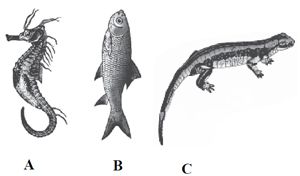
A. A and B
B. A and C
C. B and C
D. All of the above.
Answer : A

A. A and B
B. A and C
C. B and C
D. All of the above.
Answer : A
6. Identify the figures and select the correct option
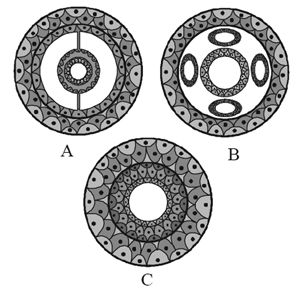
A. A - Pseudocoelomate; B - Coelomate, C-Acoelomate
B. A - Coelomate, B - Pseudocoelomate, C- Acoelomate
C. A - Coelomate; B- Acoelomate; C - Pseudocoelomate
D. A - Coelomate; B- Acoelomate; C-Eucoelomate
Answer : B

A. A - Pseudocoelomate; B - Coelomate, C-Acoelomate
B. A - Coelomate, B - Pseudocoelomate, C- Acoelomate
C. A - Coelomate; B- Acoelomate; C - Pseudocoelomate
D. A - Coelomate; B- Acoelomate; C-Eucoelomate
Answer : B
7. The given figures A, B, C and D are the examples of first true land vertebrates. They are dominant in mesozoic era and belong to phylum ‘X’. Identify ‘X’ and the animals which have four chambered heart.
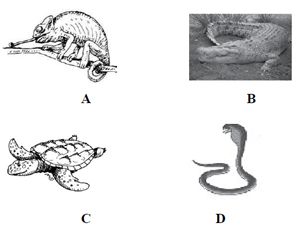
A. X – Reptile; B
B. X – Reptile; A
C. X – Amphibia, C
D. X – Pisces; D
Answer : A

A. X – Reptile; B
B. X – Reptile; A
C. X – Amphibia, C
D. X – Pisces; D
Answer : A
8. Which of the following statement(s) is/are correct regarding phylum coelenterata?
(i) They are aquatic, mostly marine, sessile or freeswimming, radially symmetrical animals.
(ii) They have a central gastro-vascular cavity with a single opening called hypostome.
(iii) Digestion is extracellular and intracellular.
(iv) Examples are Sycon, Spongilla and Euspongia.
A. (i) and (ii)
B. (i) and (iv)
C. (i), (ii) and (iii)
D. All of these
Answer : C
(i) They are aquatic, mostly marine, sessile or freeswimming, radially symmetrical animals.
(ii) They have a central gastro-vascular cavity with a single opening called hypostome.
(iii) Digestion is extracellular and intracellular.
(iv) Examples are Sycon, Spongilla and Euspongia.
A. (i) and (ii)
B. (i) and (iv)
C. (i), (ii) and (iii)
D. All of these
Answer : C
9. A student was given a specimen to identify on the basis of the characteristics given below.
(i) They are metamerically segmented.
(ii) Presence of closed circulatory system.
(iii) They have circular and longitudinal muscles for locomotion. Identify the specimen.
A. Prawn
B. Pheretima
C. Wuchereria
D. Ctenoplana
Answer : B
(i) They are metamerically segmented.
(ii) Presence of closed circulatory system.
(iii) They have circular and longitudinal muscles for locomotion. Identify the specimen.
A. Prawn
B. Pheretima
C. Wuchereria
D. Ctenoplana
Answer : B
10. Which of the following is a poisonous snake?
A. Naja (Cobra)
B. Bangarus (Krait)
C. Viper (Viper)
D. All of these
Answer : D
A. Naja (Cobra)
B. Bangarus (Krait)
C. Viper (Viper)
D. All of these
Answer : D
11. A file like rasping organ for feeding, called radula, present in the phylum __________.
A. arthropoda
B. mollusca
C. echinodermata
D. chordata
Answer : B
A. arthropoda
B. mollusca
C. echinodermata
D. chordata
Answer : B
12. In phylum echinodermata, the adult echinoderms are ______A__________ but larvae are _______B______ .
A. A radially symmetrical; B bilaterally symmetrical
B. A bilaterally symmetrical; B radially symmetrical
C. A bilaterally symmetrical; B asymmetrical
D. A metamerically segmented; B asymmetrical
Answer : A
A. A radially symmetrical; B bilaterally symmetrical
B. A bilaterally symmetrical; B radially symmetrical
C. A bilaterally symmetrical; B asymmetrical
D. A metamerically segmented; B asymmetrical
Answer : A
13. Which of the following feature is not correct regarding the figure given below?

A. It is an aquatic form.
B. Circulatory system is of open type.
C. It possesses parapodia for swimming.
D. Neural system consists of paired ganglia connected by lateral nerves to a double ventral nerve cord.
Answer : B

A. It is an aquatic form.
B. Circulatory system is of open type.
C. It possesses parapodia for swimming.
D. Neural system consists of paired ganglia connected by lateral nerves to a double ventral nerve cord.
Answer : B
14. Refer the following statement and answer the question. 'Name of X is derived from stinging capsules. It exhibits metagenesis containing two body forms in which sessile and cylindrical form is called Y and umbrella shaped and free swimming is called Z. Identify X, Y, and Z.
A. X - Coelenterate, Y - Polyp, Z - Medusa
B. X - Cnidarian, Y - Medusa, Z - Polyp
C. X - Ctenophora, Y - Radula, Z - Hypostome
D. X - Porifera, Y - Osculum, Z - Radula
Answer : A
A. X - Coelenterate, Y - Polyp, Z - Medusa
B. X - Cnidarian, Y - Medusa, Z - Polyp
C. X - Ctenophora, Y - Radula, Z - Hypostome
D. X - Porifera, Y - Osculum, Z - Radula
Answer : A
15. The given figures of animals (A & B) are distinguished on the basis of symmetry. Select the correct option which shows the type of symmetry and its description against the animals.
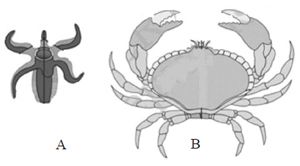
A. A : Biradial, organisms is divided into unequal halves by any plane through the central axis.
B. B: Bilateral, body is divided into equivalent right and left halves by only one plane.
C. A: Asymmetrical, organisms is not divided into equal halves by any plane through the central axis.
D. B: Radial, in which any plane passing through the central axis of the body divides the organism into two identical halves.
Answer : B

A. A : Biradial, organisms is divided into unequal halves by any plane through the central axis.
B. B: Bilateral, body is divided into equivalent right and left halves by only one plane.
C. A: Asymmetrical, organisms is not divided into equal halves by any plane through the central axis.
D. B: Radial, in which any plane passing through the central axis of the body divides the organism into two identical halves.
Answer : B
16. Which of the following is a fresh water sponge?
A. Sycon
B. Euspongia
C. Spongilla
D. Pleurobrachia
Answer C
A. Sycon
B. Euspongia
C. Spongilla
D. Pleurobrachia
Answer C
17. Which of the following phylum is being described by the given statements?
(i) They are bilaterally symmetrical,triploblastic, segmented and coelomate animals.
(ii) The body consists of head, thorax, abdomen and have jointed appendages.
(iii) Circulatory system is of open type.
(iv) Excretion takes place through malphigian tubules.
A. Arthropoda
B. Annelida
C. Mollusca
D. Echinodermata
Answer : A
(i) They are bilaterally symmetrical,triploblastic, segmented and coelomate animals.
(ii) The body consists of head, thorax, abdomen and have jointed appendages.
(iii) Circulatory system is of open type.
(iv) Excretion takes place through malphigian tubules.
A. Arthropoda
B. Annelida
C. Mollusca
D. Echinodermata
Answer : A
18. Which of the following is not a characteristic of phylum echinodermata ?
A. They have a water vascular system.
B. They have an internal skeleton.
C. They are protostomes.
D. They have bilateral symmetry at larval stage.
Answer : C
A. They have a water vascular system.
B. They have an internal skeleton.
C. They are protostomes.
D. They have bilateral symmetry at larval stage.
Answer : C
19. In which of the phylum, excretory organ like proboscis gland is present?
A. Hemichordata
B. Chordata
C. Echinodermata
D. Annelida
Answer : A
A. Hemichordata
B. Chordata
C. Echinodermata
D. Annelida
Answer : A
20. Which of the following is not the common fundamental feature for animal classification?
A. Germinal layers.
B. Pathway of water transport.
C. Pattern of organization of cells.
D. Serial repetition of the segments.
Answer : B
A. Germinal layers.
B. Pathway of water transport.
C. Pattern of organization of cells.
D. Serial repetition of the segments.
Answer : B
21. The combination of a true coelom and repeating body segmentation allows the annelids (unlike the anatomically simpler worms) to do which of the following?
A. Attain complex body shapes and thus locomote more precisely.
B. Move through loose marine sediments.
C. Be hermaphroditic.
D. Inject paralytic poisons into their prey.
Answer : A
A. Attain complex body shapes and thus locomote more precisely.
B. Move through loose marine sediments.
C. Be hermaphroditic.
D. Inject paralytic poisons into their prey.
Answer : A
22. Identify the correct characteristics of porifera.
A. (ii), (v) only
B. (i), (ii), (vi) only
C. (i), (ii), (iii), (iv) only
D. All of these.
Answer : A
- Commonly known as sea walnuts.
- Presence of ostia and collar cells.
- Exhibit tissue level of characteristics.
- It is the largest phylum of animal kingdom.
- The body is supported by spicules and sponging fibers.
- Contains cnidocytes which is used for defense, anchorage and capturing of prey.
A. (ii), (v) only
B. (i), (ii), (vi) only
C. (i), (ii), (iii), (iv) only
D. All of these.
Answer : A
23. Identify the correct characteristic feature shown by the given figure?

A. Diploblastic in nature.
B. Having radial symmetrical body.
C. Dioecious with direct development.
D. Presence of sensory tentacles on anterior head region.
Answer : D

A. Diploblastic in nature.
B. Having radial symmetrical body.
C. Dioecious with direct development.
D. Presence of sensory tentacles on anterior head region.
Answer : D
24. Which of the following traits is not shared by both sea anemones and jellyfish ?
A. A medusa as the dominant stage in the life cycle.
B. Possession of a gastro vascular cavity.
C. Sexual reproduction.
D. Nematocysts present on the tentacles.
Answer : A
A. A medusa as the dominant stage in the life cycle.
B. Possession of a gastro vascular cavity.
C. Sexual reproduction.
D. Nematocysts present on the tentacles.
Answer : A
25. Which of the following animals are bilaterally symmetrical?

A. 1 & 2
B. 2 & 4
C. 3 & 4
D. 1 & 3
Answer : B

A. 1 & 2
B. 2 & 4
C. 3 & 4
D. 1 & 3
Answer : B
26. Which of the following class is being correctly described by given statements (i - iv)?
(i) All living members of this class are ectoparasites on some fishes.
(ii) They have a sucking and circular mouth without jaws.
(iii) Circulation is of closed type.
(iv) They are marine but migrate for spawning to fresh water. After spawing, within a few days they die.
A. Cyclostomata
B. Chondrichthyes
C. Osteichthyes
D. Amphibia
Answer : A
(i) All living members of this class are ectoparasites on some fishes.
(ii) They have a sucking and circular mouth without jaws.
(iii) Circulation is of closed type.
(iv) They are marine but migrate for spawning to fresh water. After spawing, within a few days they die.
A. Cyclostomata
B. Chondrichthyes
C. Osteichthyes
D. Amphibia
Answer : A
27. Which of the following statement is incorrect?
A. Platyhelminthes has incomplete digestive system.
B. In coelenterates, the arrangement of cells is more complex.
C. Nereis is monoecious but earthworms and leeches are dioecious.
D. Simple and compound eyes are present in the animals of those phylum whose over two-thirds of all named species on earth are arthropods.
Answer : C
A. Platyhelminthes has incomplete digestive system.
B. In coelenterates, the arrangement of cells is more complex.
C. Nereis is monoecious but earthworms and leeches are dioecious.
D. Simple and compound eyes are present in the animals of those phylum whose over two-thirds of all named species on earth are arthropods.
Answer : C
28. Hemichordates have now been placed with the nonchordates, close to echinoderms, because true
A. notochord is absent.
B. pharyngeal gill-slits are lacking.
C. dorsal nerve cord is absent.
D. heart is lacking.
Answer : A
A. notochord is absent.
B. pharyngeal gill-slits are lacking.
C. dorsal nerve cord is absent.
D. heart is lacking.
Answer : A
29. The transition from aquatic to terrestrial lifestyles required many adaptations in the vertebrate lineage. Which of the following is not one of those adaptations ?
A. Switch from gill respiration to air-breathing lungs.
B. Improvements in water resistance of skin.
C. Alteration in mode of locomotion.
D. Development of feathers for insulation.
Answer : D
A. Switch from gill respiration to air-breathing lungs.
B. Improvements in water resistance of skin.
C. Alteration in mode of locomotion.
D. Development of feathers for insulation.
Answer : D
30. Which of the following belong to phylum arthropoda?
A. Bombyx and Apis
B. Laccifer and Anopheles
C. Locusta and Limulus
D. All of the above
Answer : D
A. Bombyx and Apis
B. Laccifer and Anopheles
C. Locusta and Limulus
D. All of the above
Answer : D
31. Which of the following is a chordate feature and not shared by the non-chordates ?
A. Metamerism
B. Axial organization
C. Bilateral symmetry
D. Pharyngeal gill slits
Answer : D
A. Metamerism
B. Axial organization
C. Bilateral symmetry
D. Pharyngeal gill slits
Answer : D
32. Match the terms/feature given in column I with their examples given in column II and select the correct match from the option given below.
A. A - i, B - ii, C - iii, D - iv, E - v
B. A - iii, B - v, C - ii, D - iv, E - i
C. A - iii, B - i, C - v, D - ii, E - iv
D. A - v, B - iv, C - iii, D - i, E - ii
Answer : D
| Column-I | Column-II |
|---|---|
| (Term/Feature) | (Examples) |
| A. Gregarious pest | i. Hirudinaria |
| B. Vector | ii. Planaria |
| C. Oviparous with | iii. Sepia indirect development |
| D. Metameres | iv. Aedes |
| E. High regeneration | v. Locust capacity |
A. A - i, B - ii, C - iii, D - iv, E - v
B. A - iii, B - v, C - ii, D - iv, E - i
C. A - iii, B - i, C - v, D - ii, E - iv
D. A - v, B - iv, C - iii, D - i, E - ii
Answer : D
33. Which one of the following features is common in silverfish, scorpion, dragonfly and prawn?
A. Three pairs of legs and segmented body.
B. Chitinous cuticle and two pairs of antennae.
C. Jointed appendages and chitinous exoskeleton.
D. Cephalothorax and tracheae.
Answer : C
A. Three pairs of legs and segmented body.
B. Chitinous cuticle and two pairs of antennae.
C. Jointed appendages and chitinous exoskeleton.
D. Cephalothorax and tracheae.
Answer : C
34. Meandrina (brain coral) belongs to phylum
A. porifera
B. coelenterata
C. ctenophora
D. platyhelminthes
Answer : B
A. porifera
B. coelenterata
C. ctenophora
D. platyhelminthes
Answer : B
35. Refer the given figures A, B, C and D and identify the option which shows their correct name.
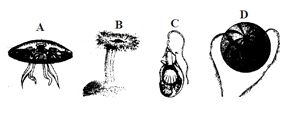
A. A - Pleurobrachia, B - Cnidoblast, C - Aurelia, D - Adamsia
B. A - Aurelia, B - Adamsia, C - Cnidoblast, D - Pleurobrachia
C. A - Cnidoblast, B - Pleurobrachia, C - Adamsia, D - Aurelia
D. A - Adamsia, B - Aurelia, C - Pleurobrachia, D - Cnidoblast
Answer : B

A. A - Pleurobrachia, B - Cnidoblast, C - Aurelia, D - Adamsia
B. A - Aurelia, B - Adamsia, C - Cnidoblast, D - Pleurobrachia
C. A - Cnidoblast, B - Pleurobrachia, C - Adamsia, D - Aurelia
D. A - Adamsia, B - Aurelia, C - Pleurobrachia, D - Cnidoblast
Answer : B
36. Few cnidarians like corals have a skeleton composed of
A. calcium hydroxide
B. calcium sulphate
C. calcium carbonate
D. sodium bicarbonate
Answer : C
A. calcium hydroxide
B. calcium sulphate
C. calcium carbonate
D. sodium bicarbonate
Answer : C
37. The given figure shows some characteristic features marked as chordates. Identify the correct labelling A,B,C and D.
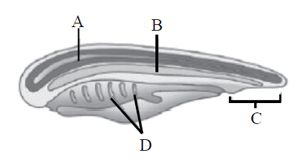
A. A-Notochord; B-Post-anal part; C-Gill slits; D-Nerve cord
B. A-Nerve cord; B-Notochord; C-Post-anal part; D-Gill slits
C. A-Notochord; B-Nerve cord; C-Gill slits; D-Post-anal part
D. A-Gill slits; B-Post-anal part; C-Nerve cord; D-Notochord
Answer : B

A. A-Notochord; B-Post-anal part; C-Gill slits; D-Nerve cord
B. A-Nerve cord; B-Notochord; C-Post-anal part; D-Gill slits
C. A-Notochord; B-Nerve cord; C-Gill slits; D-Post-anal part
D. A-Gill slits; B-Post-anal part; C-Nerve cord; D-Notochord
Answer : B
38. Which of the follwoing statement(s) is/are correct?
(i) Organ systems in different group of animals show various patterns of complexities.
(ii) The digestive system in platyhelminthes has only a single opening to the outside of the body that serve as both mouth and anus, and is hence called complete.
(iii) In open type of circulatory system, the blood is pumped out of the heart and the cells and tissues are directly bathed in it.
(iv) In closed type, the blood is circulated through a series of vessels of varying diameters (arteries, veins and capillaries).
A. Only (i)
B. Both (ii) and (iii)
C. (i), (iii) and (iv)
D. All of these
Answer : C
(i) Organ systems in different group of animals show various patterns of complexities.
(ii) The digestive system in platyhelminthes has only a single opening to the outside of the body that serve as both mouth and anus, and is hence called complete.
(iii) In open type of circulatory system, the blood is pumped out of the heart and the cells and tissues are directly bathed in it.
(iv) In closed type, the blood is circulated through a series of vessels of varying diameters (arteries, veins and capillaries).
A. Only (i)
B. Both (ii) and (iii)
C. (i), (iii) and (iv)
D. All of these
Answer : C
39. Polyp phase is absent in
A. Hydra
B. Aurelia
C. Physalia
D. Obelia
Answer : B
A. Hydra
B. Aurelia
C. Physalia
D. Obelia
Answer : B
40. Match the phylum given in column - I with the special features present in them given in column - II and choose the correct option.
A. A III; B IV; C V; D II; E I
B. A IV; B III; C V; D II; E I
C. A III; B IV; C II; D V; E I
D. A III; B V; C IV; D II; E I
Answer : A
| Column -I | Column- II |
|---|---|
| (Phylum) | (Special features present) |
| A. Porifera | I. Mammary glands |
| B. Mollusca | II. Cloaca |
| C. Ctenophora | III. Choanocytes |
| D. Amphibia | IV. Radula |
| E. Mammalia | V. Comb plates |
A. A III; B IV; C V; D II; E I
B. A IV; B III; C V; D II; E I
C. A III; B IV; C II; D V; E I
D. A III; B V; C IV; D II; E I
Answer : A
41. A common characteristic of all vertebrates without exception is
A. the division of body into head, neck, trunk and tail.
B. body covered with exoskeleton.
C. the possession of two pairs of functional appendages.
D. the presence of well- developed skull.
Answer : D
A. the division of body into head, neck, trunk and tail.
B. body covered with exoskeleton.
C. the possession of two pairs of functional appendages.
D. the presence of well- developed skull.
Answer : D
42. Select the incorrect feature of mollusca from the given statements.
A. (i) and (ii) only
B. (ii) and (iv) only
C. (i), (ii) and (iv) only
D. All the five statements.
Answer : C
- Terrestrial or aquatic animals having cellular system level of organization.
- Radial symmetrical and acoelomate animals and possesses two germinal layers.
- A file like rasping organ called radula is present.
- Usually dioecious and viviparous animals.
- Examples include Pila, Octopus, and Dentalium.
A. (i) and (ii) only
B. (ii) and (iv) only
C. (i), (ii) and (iv) only
D. All the five statements.
Answer : C
43. Which of the following statement(s) is/are correct?
(i) Animals in which the cells are arranged in two embryonic layers, an external ectoderm and an internal endoderm, are called diploblastic animals.
(ii) Notochord is an ectodermally derived rod like structure formed on the ventral side during embryonic development in some animals.
(iii) In some animals, the body cavity is not lined by mesoderm, instead, the mesoderm is present as scattered pouches in between the ectoderm and endoderm and such a body cavity is called pseudocoelom.
A. Only (i)
B. Both (i) and (ii)
C. Both (i) and (iii)
D. All of these
Answer : C
(i) Animals in which the cells are arranged in two embryonic layers, an external ectoderm and an internal endoderm, are called diploblastic animals.
(ii) Notochord is an ectodermally derived rod like structure formed on the ventral side during embryonic development in some animals.
(iii) In some animals, the body cavity is not lined by mesoderm, instead, the mesoderm is present as scattered pouches in between the ectoderm and endoderm and such a body cavity is called pseudocoelom.
A. Only (i)
B. Both (i) and (ii)
C. Both (i) and (iii)
D. All of these
Answer : C
44. Animals like annelids, arthropods, etc. where the body can be divided into identical left and right halves in only one plane, exhibit___________symmetry.
A. radial
B. bilateral
C. asymmetrical
D. non- symmetrical
Answer : A
A. radial
B. bilateral
C. asymmetrical
D. non- symmetrical
Answer : A
45. Tracheae of cockroach and mammal are similar in having
A. paired nature.
B. non-collapsible walls.
C. ciliated inner lining.
D. origin from head.
Answer : B
A. paired nature.
B. non-collapsible walls.
C. ciliated inner lining.
D. origin from head.
Answer : B
46. Which of the following group of animals reproduces only by sexual means?
A. Ctenophora
B. Cnidaria
C. Porifera
D. Protozoa
Answer : A
A. Ctenophora
B. Cnidaria
C. Porifera
D. Protozoa
Answer : A
47. In phylum arthropoda, excretion takes place through
A. nephridia
B. flame cells
C. malphigian tubules
D. gills
Answer : C
A. nephridia
B. flame cells
C. malphigian tubules
D. gills
Answer : C
48. Aquatic annelids (like Nereis) possess lateral appendages called ______________, which help in swimming.
A. visceral hump
B. parapodia
C. radula
D. spicules
Answer : B
A. visceral hump
B. parapodia
C. radula
D. spicules
Answer : B
49. Flame cells preset in platyhelminthes, are specialized in
A. respiration and absorption.
B. osmoregulation and circulation.
C. respiration and excretion.
D. osmoregulation and excretion.
Answer : D
A. respiration and absorption.
B. osmoregulation and circulation.
C. respiration and excretion.
D. osmoregulation and excretion.
Answer : D
50. Which of the following class is being described by the given statements (i - iv)?
(i) They are found in a variety of habitats- polar ice-caps, deserts, mountains, forests, grasslands and dark caves.
(ii) Most unique mammalian characteristic is the presence of mammary glands by which the young ones are nourished.
(iii) Heart is four-chambered.
(iv) Sexes are separate and fertilization is internal.
A. Reptilia
B. Aves
C. Mammalia
D. Amphibia
Answer : C
(i) They are found in a variety of habitats- polar ice-caps, deserts, mountains, forests, grasslands and dark caves.
(ii) Most unique mammalian characteristic is the presence of mammary glands by which the young ones are nourished.
(iii) Heart is four-chambered.
(iv) Sexes are separate and fertilization is internal.
A. Reptilia
B. Aves
C. Mammalia
D. Amphibia
Answer : C
Sharing is caring
Related Post
1000+ Computer Fundamental Multiple Choice Question Answer [Solved]
Sentence Correction 1000+ MCQ with answer for SSC CHSL
1000+ Urologic infections and inflammations Multiple Choice Question Answer [Solved]
Building Construction MCQ Solved Paper for NDA
Urology Basic Science 1000+ MCQ with answer for ESIC
1000+ Networking MCQ for RBI Assistant [Solved]